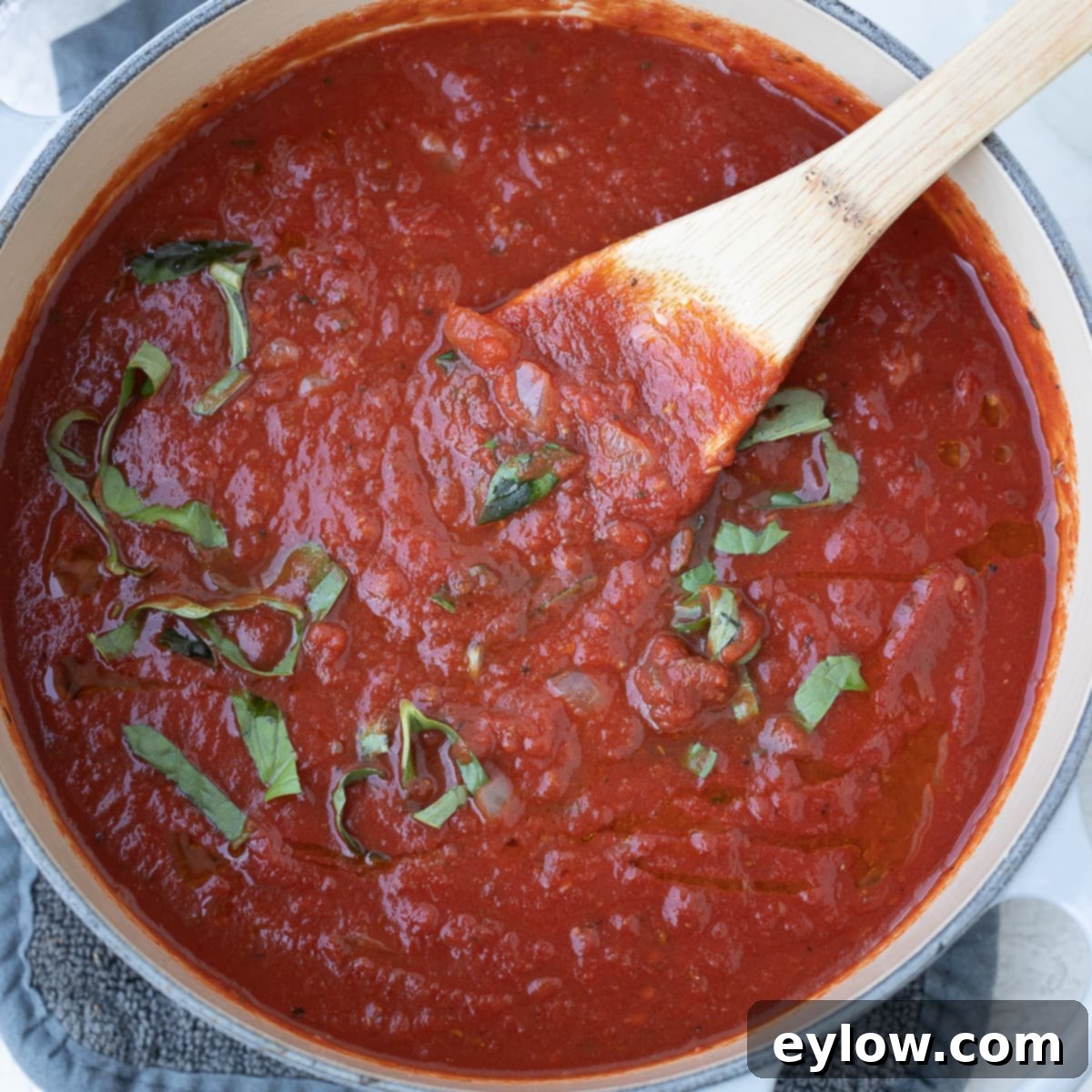Craft the Perfect Homemade Marinara Sauce: An Easy, Flavorful & Freezer-Friendly Recipe
Imagine a rich, aromatic sauce bubbling gently on your stovetop, filling your kitchen with an inviting fragrance. This easy homemade pasta sauce, often called marinara, transforms a few simple pantry staples into a culinary masterpiece in about 30 minutes. Forget the expensive, often overly sweet or acidic jarred versions; crafting your own means a fresher, more flavorful, and significantly more budget-friendly experience. Perfect draped over a generous serving of pasta, enhancing grilled chicken, or serving as a versatile foundation for countless other dishes, this sauce promises a delicious dinner with minimal fuss. Plus, it freezes beautifully, ensuring you always have a wholesome, ready-to-use batch for those hectic weeknights.

The journey to embracing homemade marinara often begins with a realization. A friend recently shared her frustration over the rising cost of a popular Italian restaurant’s jarred marinara, a favorite among her children. After tasting my homemade version, she was not only impressed by the superior flavor but also astonished to learn it could be made for less than half the price of her usual store-bought option. While commercial sauces can be convenient in a pinch, making your own offers unparalleled freshness, flavor depth, and cost savings. This recipe is your invitation to bypass the jars and elevate your everyday meals with a truly authentic and satisfying marinara sauce.
[feast_advanced_jump_to]
Why You’ll Love This Easy Marinara Sauce Recipe
This isn’t just another pasta sauce recipe; it’s a kitchen game-changer. Here’s why this homemade marinara will quickly become a cherished favorite in your culinary repertoire:
- Effortless Simplicity with Pantry Staples: You don’t need exotic ingredients or advanced culinary skills. This recipe relies on readily available items like quality canned tomatoes, fresh garlic, and onions, making it accessible for any home cook. The beauty lies in transforming these basic components into something truly extraordinary with minimal effort.
- Incredibly Versatile and Flavorful: Whether you call it spaghetti sauce, basic tomato sauce, or marinara, its rich, savory profile is universally appealing. It’s a foundational sauce that can be adapted to countless dishes and personal preferences, proving itself as an indispensable kitchen staple. Its robust flavor makes even simple pasta dishes feel gourmet.
- Perfect for Meal Prep and Freezing: Prepare a generous batch of this sauce, and you’ll thank yourself during busy weeks. It stores beautifully in the freezer, allowing you to have homemade deliciousness at your fingertips, ready to transform a quick meal into a hearty, satisfying dinner without any last-minute stress. Say goodbye to rushed takeout or compromise on flavor!
Essential Ingredients for Your Homemade Marinara
Crafting a truly exceptional homemade pasta sauce starts with quality ingredients. This recipe uses straightforward items, but choosing them wisely makes all the difference. Refer to the recipe card below for precise quantities.

- Cooking Fat: Extra Virgin Olive Oil
Using a good quality extra virgin olive oil is key. It’s not just for sautéing the onion and garlic; it provides a foundational richness and healthy fats that enhance the overall flavor profile of the sauce. The fruity, peppery notes of a robust olive oil truly shine through.
- Aromatic Base: Onion
Onions are fundamental to many great sauces, and marinara is no exception. Finely chopped onion slowly sautéed until translucent creates a sweet, aromatic base that adds crucial depth of flavor to the sauce. It’s the silent hero that builds complexity.
- Flavor Booster: Garlic
Fresh garlic is non-negotiable for an authentic marinara. Its pungent, savory kick is a cornerstone of Italian cuisine. While pre-peeled refrigerated cloves can be convenient, ensure they are fresh for the best flavor. Store whole heads of garlic in a cool, dark pantry to maintain their potency for weeks.
- Herbaceous Notes: Basil (Dried & Fresh)
This recipe cleverly uses both dried and fresh basil. Dried basil, added early in the cooking process, infuses the sauce with a deep, earthy basil flavor as it rehydrates and melds with other ingredients. Fresh basil, stirred in at the very end, brightens the sauce with its vibrant, aromatic essence. For an alternative, a good quality Italian seasoning blend can be used in place of dried basil.
- Optional, Yet Delightful Spices: Ground Anise Seed or Fennel Seed
For an unexpected layer of traditional Italian flavor, consider adding ground anise seed or ground fennel seed. Fennel seed offers a milder, slightly sweet licorice-like taste, while anise seed is more potent and distinctly sweeter. Both provide a wonderful warmth and depth that elevate the marinara. While optional, these spices are a secret weapon for a truly authentic taste. Feel free to use one or both, depending on your preference.
- The Heart of the Sauce: Tomatoes
The choice of tomatoes is paramount. This recipe calls for a combination of canned crushed tomatoes and plain canned tomato sauce. This blend provides both texture and a smooth consistency. Many chefs swear by San Marzano tomatoes for their balanced sweetness and low acidity, but excellent quality crushed tomatoes from other regions, like California, can also yield fantastic results. It’s important to understand what makes a good canned tomato, which we’ll discuss further below.
- Flavor Enhancer: Red Wine (Optional)
A splash of red wine can significantly enhance the depth and aroma of your marinara sauce. The alcohol evaporates during simmering, leaving behind complex fruity and earthy notes. You don’t need an expensive bottle; inexpensive, airline-sized bottles are perfect for cooking small quantities. If you prefer to omit alcohol, vegetable broth or water can be used as a substitute.
Chef’s Tip on Tomatoes: Authentic San Marzano tomatoes from Italy’s Agro Sarnese Nocerino region are highly prized for their balanced sweetness, low acidity, fewer seeds, and thick flesh. Look for the “certified D.O.P.” (Protected Designation of Origin) label on the can to ensure you’re getting the real deal. They often come at a higher price point, and many discerning cooks find them worth the investment. However, be wary of imposters; unfortunately, the market can contain counterfeit San Marzano products, so always check for the D.O.P. certification rather than relying solely on branding or price. Excellent alternatives exist, including high-quality California-grown canned tomatoes, which have also received accolades for their flavor and consistency. Choose a brand known for quality to ensure a robust tomato base for your sauce.
Customizing Your Homemade Pasta Sauce: Substitutions and Variations
One of the joys of making marinara from scratch is the ability to easily adapt it to your taste and dietary preferences. Here are several ways to customize your homemade pasta sauce:
- Spice It Up: Create a Spicy Marinara Sauce
For those who love a kick, add extra red pepper flakes (often called pizza pepper) along with the dried herbs. Start with an additional ¼ teaspoon and taste before adding more, as the heat can intensify during simmering. You could also introduce a pinch of cayenne pepper for a different kind of warmth.
- Achieve Your Desired Texture: Smooth or Chunky Sauce
If you prefer a perfectly smooth, velvety marinara, puree the sauce after it has simmered. You can achieve this using an immersion blender directly in the pot, a standard blender (be careful with hot liquids, blending in batches and venting the lid), or a food processor. For a more rustic, chunky texture, simply leave it as is after simmering, enjoying the natural texture of the crushed tomatoes.
- Hearty Addition: Make it a Meat Sauce
Transform this marinara into a robust meat sauce by adding cooked ground meat. Brown a couple of Italian sausage links (removed from their casings and crumbled), ground beef, ground pork, or even ground bison (which creates a lean and flavorful bolognese-style sauce) before adding the onions. Drain any excess fat, then proceed with the recipe. Allow the meat to simmer with the sauce for at least 30-40 minutes to fully meld the flavors.
- Alcohol-Free Option: Skip the Wine
If you prefer to cook without alcohol, simply omit the red wine. The sauce will still be delicious. You can replace the ¼ cup of wine with an equal amount of vegetable broth, chicken broth, or even water to maintain the liquid consistency, though it will subtly alter the flavor profile. Beef broth can also add a nice depth if you’re making a meat sauce.
- Experiment with Herbs: Vary the Herb Profile
While basil is classic, feel free to explore other herbs. Try substituting dried oregano for dried basil or using a combination of dried herbs like oregano, thyme, and marjoram. Remember to add a handful of fresh chopped herbs (like fresh oregano or parsley) at the very end of cooking, just before serving, to preserve their bright flavors and vibrant colors.
Working with Whole Tomatoes
Should you only have whole canned tomatoes on hand, don’t fret! They can easily be prepared for this recipe. First, strain the liquid from the can into a separate bowl and set it aside. Then, working over a sink or another bowl (as it can be a bit messy), use your fingers to gently split open the whole tomatoes and remove any tough cores or seeds. Once prepared, briefly puree the tomatoes with some of their reserved liquid in a blender or food processor. Alternatively, you can chop them by hand for a more rustic texture. The goal is to break them down, but avoid pureeing them completely smooth; leave some texture for a more satisfying sauce. This method effectively replaces crushed tomatoes in the recipe.
Adapting for Tomato Paste instead of Tomato Sauce
If you find yourself without plain canned tomato sauce but have tomato paste, it’s an easy fix. Simply mix equal parts tomato paste and water (e.g., if the recipe calls for 15 ounces of tomato sauce, use 7.5 ounces of tomato paste and 7.5 ounces of water) and stir until smooth to create a suitable substitute. If your sauce appears too thick during simmering, thin it out gradually with a little water or vegetable broth until it reaches your desired consistency.
Another viable option is to use only crushed tomatoes, omitting the plain tomato sauce entirely. This will result in a chunkier marinara sauce, which many prefer. If you desire a smoother texture with this approach, you can always use an immersion blender or standard blender to puree a portion or all of the sauce after cooking.
Step-by-Step Recipe Instructions for Perfect Marinara
This homemade marinara sauce recipe is praised for its simplicity, both in its ingredients and the straightforward cooking process. Follow these steps to create a rich and flavorful sauce:
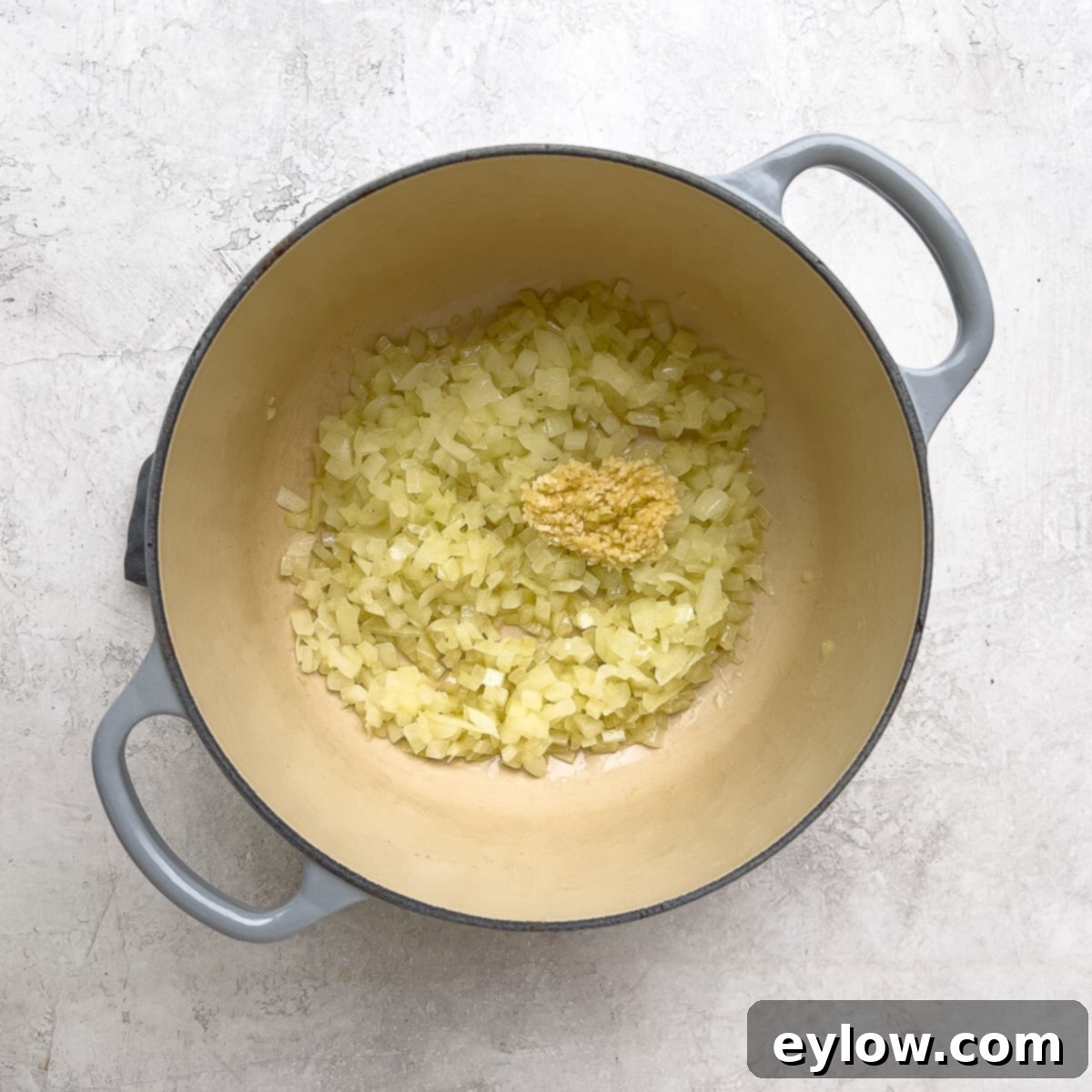
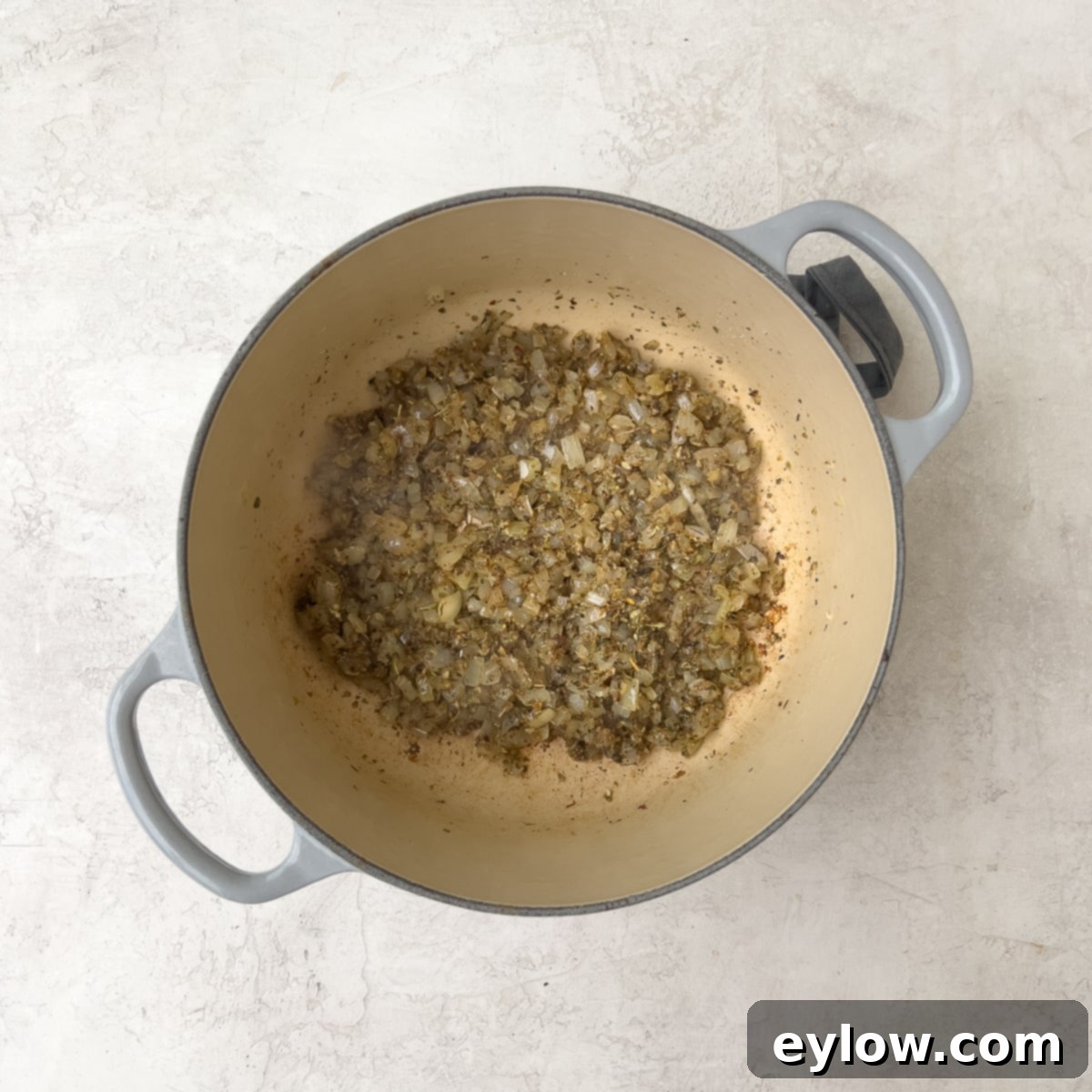
Initial Sauté: Begin by heating the olive oil in a substantial pot, such as a Dutch oven, over medium-low heat. Heavy pots are ideal because they distribute heat evenly, preventing scorching and allowing ingredients to cook thoroughly at lower temperatures. Add the finely chopped onion and cook, stirring occasionally, until it becomes soft, translucent, and fragrant, typically 5-7 minutes. Be patient here, as proper caramelization of the onion forms a crucial flavor base. Next, add the minced garlic along with your dried herbs (basil or Italian blend), ground anise or fennel seed, black pepper, red pepper flakes, and salt. Cook for another 1-2 minutes, stirring constantly, until the garlic is fragrant. Be careful not to burn the garlic, as it can turn bitter quickly.
Simmering to Perfection: Now, pour in the crushed tomatoes and plain tomato sauce. If you’re using red wine, add it at this stage. Stir everything together well, ensuring all ingredients are combined. Increase the heat slightly to bring the sauce to a gentle bubble, then reduce the heat to a low simmer. Cover the pot and let the sauce cook for at least 20 minutes. Simmering allows the flavors to deepen and meld together beautifully. If time permits, letting it simmer for an additional 10-20 minutes will further enhance its richness and complexity.

Final Adjustments: After simmering, taste the sauce and adjust seasonings as needed. If the sauce has a slightly tart or acidic taste, you can balance it by stirring in a small amount of sugar (about ½ to 1 teaspoon) or a neutral-flavored sweetener like monk fruit. This helps to round out the tomato flavor without making the sauce overly sweet. If using fresh chopped basil leaves, stir them in just before serving; their delicate flavor and aroma are best preserved when added at the very end of the cooking process. Your delicious homemade marinara is now ready to serve or cool and freeze for future meals.
Chef’s Tip on Cooking with Wine: When incorporating wine into your cooking, remember the golden rule: only cook with wine you would genuinely enjoy drinking. “Cooking wines” often contain added salt and preservatives that can negatively impact your dish’s flavor. For recipes like this that require a small quantity, individual airline-sized bottles of red wine are an economical and convenient solution, allowing you to avoid opening a full bottle. It’s crucial to add the wine early in the cooking process, allowing it to simmer with the sauce. This gives the alcohol sufficient time to evaporate, leaving behind only the rich, complex flavors and aromas that enhance the dish.
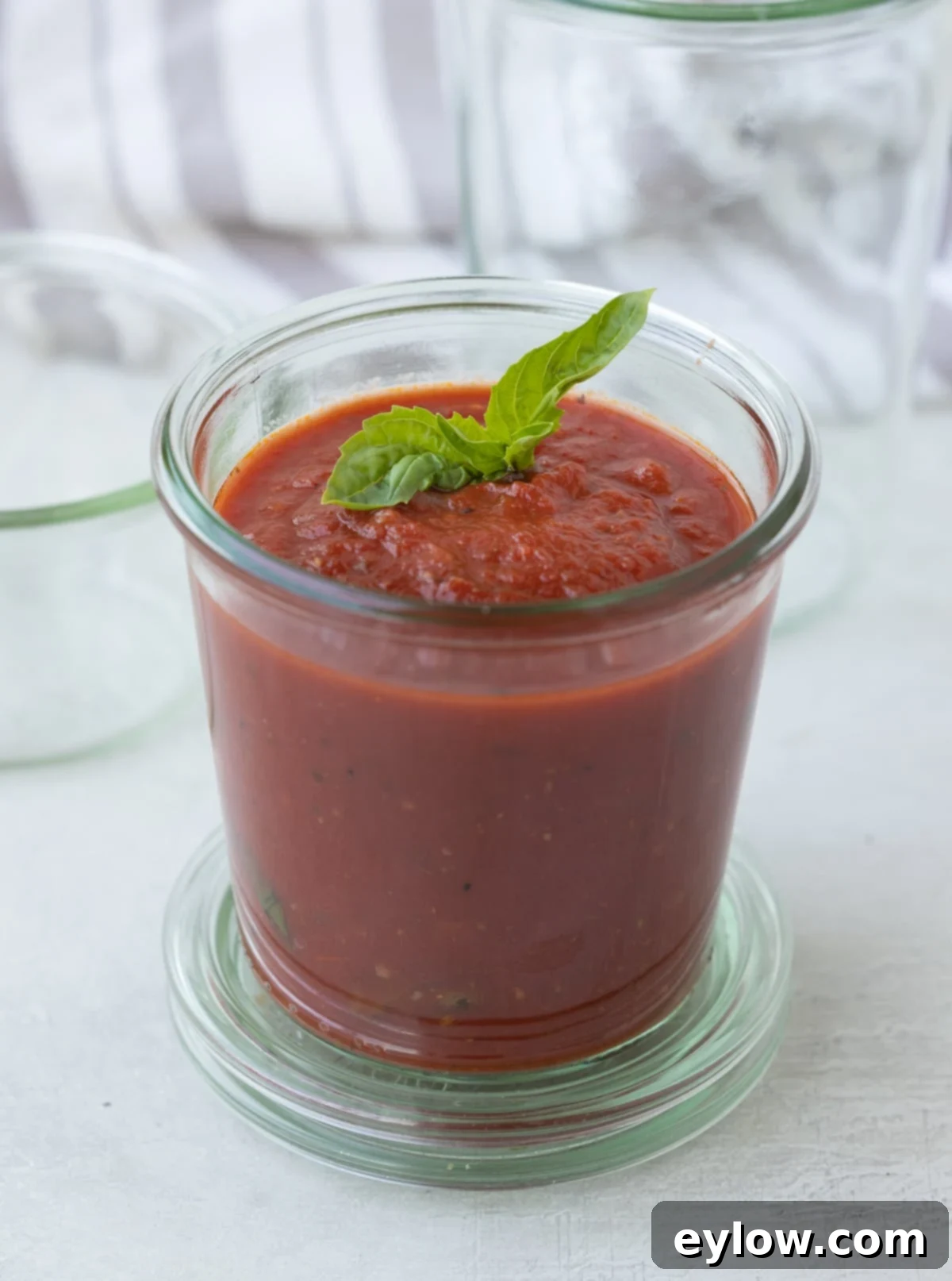
Delicious Ways to Enjoy Your Homemade Marinara Sauce
The versatility of homemade marinara is one of its greatest assets. Beyond its obvious pairing with pasta, this flavorful sauce can elevate a multitude of dishes. Here are some inspiring serving suggestions to make the most of your fresh batch:
- Classic Pasta Dish: Serve over your favorite pasta – spaghetti, linguine, penne, or rigatoni – for a simple yet satisfying meal. Garnish generously with fresh herbs like basil or parsley and a sprinkle of grated Parmesan or Pecorino Romano cheese.
- Elegant Chicken Parmesan: This marinara is the perfect foundation for making quick and easy Chicken Parmesan. Its balanced flavors complement the crispy breaded chicken and melted cheese beautifully.
- Appetizer Dipping Sauce: Serve it warm as a dipping sauce for mozzarella sticks, arancini, garlic knots, or crusty bread. It’s always a crowd-pleaser!
- Homemade Pizza Sauce: Spread a thin layer of this vibrant marinara over your pizza dough before adding cheese and toppings. Its fresh taste will make your homemade pizza truly shine.
- Italian-Style Spicy Stovetop Shrimp: Quickly sauté shrimp with a generous amount of this marinara for a flavorful, spicy stovetop shrimp dish, perfect served over rice or with crusty bread for dipping.
- Simmer Italian Meatballs: Gently simmer your favorite Italian meatballs directly in this marinara sauce. The meatballs will absorb the sauce’s flavors, making them incredibly tender and delicious.
- Eggplant Parmesan or Lasagna: Use this marinara as the rich tomato layer in your homemade eggplant parmesan or a classic lasagna. Its homemade quality will elevate these layered dishes to new heights.

Storing and Freezing Homemade Marinara
This recipe yields approximately 5 cups of delicious homemade tomato marinara, providing plenty for immediate use and future meals. Proper storage ensures its freshness and extends its shelf life:
- Refrigeration: Once cooled, transfer the sauce to an airtight container. It will keep beautifully in the refrigerator for up to 5 days. Ensure the container is sealed tightly to prevent absorption of other odors and maintain freshness.
- Freezing: For longer storage, this marinara sauce freezes exceptionally well. Allow the sauce to cool completely before transferring it to freezer-safe containers or heavy-duty freezer bags. If using bags, lay them flat on a baking sheet to freeze, then store them upright to save space. Label with the date. Frozen marinara can be stored for up to 3-4 months. To use, simply thaw overnight in the refrigerator or gently reheat from frozen in a pot over low heat, stirring occasionally. Freezing in smaller portions (e.g., 1-2 cup servings) is ideal for quick weeknight dinners, as you can thaw just what you need.
Common Questions About Marinara Sauce
Chefs revere San Marzano tomatoes for several key characteristics that contribute to an exceptional marinara sauce. These specific plum tomatoes boast a lower acidity level, resulting in a naturally sweeter sauce. They also contain fewer seeds and have a thicker, meatier flesh, which creates a more substantial and less watery texture. The combined result is a terrifically balanced and flavorful tomato base. While they can cost more than regular canned tomatoes, many culinary professionals and home cooks believe their superior quality is well worth the investment. However, as noted in our chef’s tip, there are many other delicious canned tomato brands available that can still produce an outstanding marinara.
The distinction between spaghetti sauce and marinara often comes down to complexity, cooking time, and the presence of meat. Generally, “spaghetti sauce” tends to be a broader term that often implies a heartier, more complex sauce that includes ground meat (like beef, pork, or a combination) and simmers for a longer period, sometimes hours, to develop deep, rich flavors. Marinara, on the other hand, is traditionally a simpler, lighter, and quicker-cooking tomato sauce. It typically does not contain meat and focuses on the bright, fresh flavors of tomatoes, garlic, onion, and herbs. While marinara can be the base for a meat sauce, it’s defined by its meat-free essence. Think of the thick, rich texture of a bolognese sauce – a prime example of a meat-heavy “spaghetti sauce” – and then consider trying this recipe with ground bison for a unique twist.
The name “marinara” originates from the Italian word “marinaro,” meaning “mariner” or “sailor.” Historically, it’s believed that marinara sauce was the preferred sauce of Italian sailors (or “mariners”) because it was quick to prepare with readily available, non-perishable ingredients like canned tomatoes, garlic, and herbs. It could be cooked on long voyages and was a staple for their simple meals. This classic Italian and Italian-American sauce remains a testament to efficient, flavorful cooking, embodying the spirit of its humble maritime origins. Its rapid preparation time and vibrant flavor profile made it ideal for sailors and busy cooks alike, ensuring a delicious meal was never far away.
Explore More Delicious Tomato Sauce Recipes
If you’ve fallen in love with the simplicity and rich flavor of homemade tomato marinara, you’re in good company! We also adore versatile and vibrant tomato-based sauces. Here are a few more delightful ideas to inspire your next culinary creation, showcasing the incredible potential of the humble tomato:
- The Best Roasted Tomato Sauce
- Bison Bolognese (Ground Bison Meat Sauce)
- Mushroom Tomato Sauce
- Sun-Dried Tomato Pesto (Pesto Rosso)
⭐️Loved This Recipe? Share Your Experience!
If you’ve whipped up this delightful homemade marinara sauce, we’d be absolutely thrilled to hear from you! Please take a moment to leave a comment below and share your thoughts. If this recipe became a new favorite, consider giving it a 5-star rating! Your feedback and ratings are incredibly valuable – they help other readers discover and enjoy this recipe, and we truly love connecting with our community.
📖 Recipe
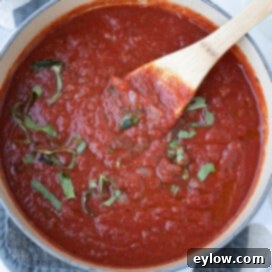
Easy Homemade Marinara Sauce
Sally Cameron
Pin Recipe
Equipment
-
Large pot or Dutch Oven 4-5 quarts
Ingredients
- 2 tablespoons extra virgin olive oil
- 1 cup finely chopped yellow onion
- 3 large garlic cloves minced or finely chopped
- 1 tablespoon dried basil or Italian herb blend
- 1 ½ teaspoons ground anise seed or fennel seed (optional, for added authentic flavor)
- ¼ teaspoon freshly ground black pepper
- ¼ teaspoon red pepper flakes adjust to your preferred level of heat
- ¼ teaspoon sea salt (or to taste)
- 28 ounces can crushed tomatoes (good quality)
- 15 ounces can plain tomato sauce
- ¼ cup red wine optional, use a dry red; airline-sized bottles are convenient
- 1 handful fresh chopped basil leaves optional, for garnish and fresh flavor at the end
Instructions
Prepare the Aromatic Base
-
In a medium-sized, heavy-bottomed pot or Dutch oven, heat the extra virgin olive oil over medium-low heat. Add the finely chopped onion and sauté gently until it becomes soft, translucent, and fragrant, typically for 5-7 minutes. Stir occasionally to ensure even cooking and prevent browning. Once the onion is softened, add the minced garlic, dried basil (or Italian herb blend), ground anise or fennel seed (if using), black pepper, red pepper flakes, and sea salt. Cook for an additional 1-2 minutes, stirring constantly, until the garlic is fragrant. Be very careful not to let the garlic brown or burn, as it can impart a bitter taste to the sauce.
Combine and Simmer to Develop Flavors
-
Pour in the canned crushed tomatoes and plain tomato sauce. If you are opting to use red wine, add it now as well. Stir all the ingredients together thoroughly until they are well combined. Increase the heat slightly to bring the sauce to a gentle bubble, then immediately reduce the heat to a low simmer. Cover the pot and let the sauce simmer for at least 20 minutes to allow the flavors to fully meld and deepen. For a smoother sauce texture, you can briefly puree the sauce using an immersion blender directly in the pot, or carefully transfer it to a standard blender (in batches) after cooking.
Just before serving, or after the sauce has finished simmering, stir in the fresh chopped basil leaves (if using). This adds a bright, fresh aromatic finish to your homemade marinara. Taste and adjust for salt, pepper, or a pinch of sugar if the acidity needs balancing.
Notes
Fennel seed generally offers a milder, slightly sweet, and licorice-like flavor. Anise seed, while similar, tends to be more potent and distinctly sweeter in its licorice notes. Both spices contribute a wonderful layer of authentic Italian flavor to marinara. You can choose to use one or both, depending on your personal preference for that specific aromatic profile. Keep in mind that fennel and anise come from two different plants, providing unique, yet complementary, flavor nuances.
These spices are available in both whole and pre-ground forms. Whole spices and herbs typically retain their freshness and potency longer than their pre-ground counterparts. However, pre-ground options offer greater convenience for immediate use. If you opt for whole spices, they will need to be ground before being incorporated into the sauce to release their full flavor. An inexpensive coffee grinder, dedicated solely to grinding spices and herbs, works perfectly for this task.
How to Use Your Versatile Marinara Sauce:
This homemade marinara is incredibly versatile. Use it generously for classic pasta dishes, as a rich base for chicken or eggplant parmesan, a flavorful sauce for sautéed shrimp or fish, or to simmer tender meatballs. It’s also an excellent foundation for lasagna, baked ziti, or as a vibrant pizza sauce, proving its worth in countless Italian and American-Italian inspired meals.
